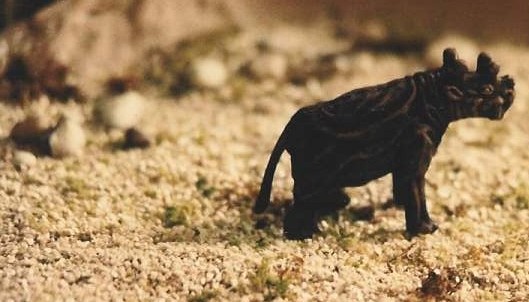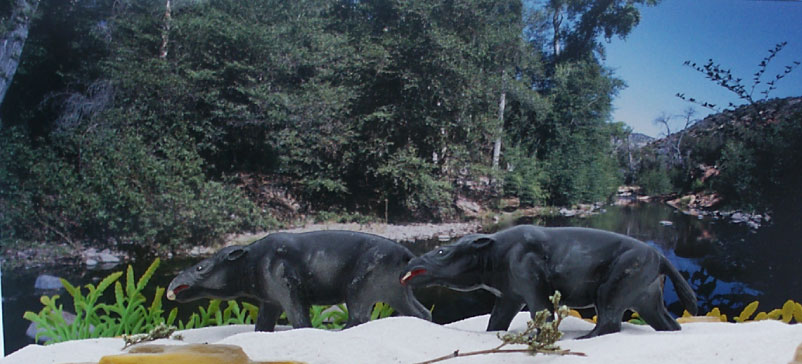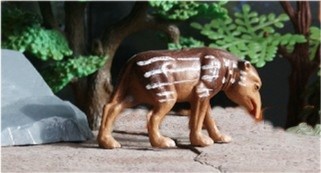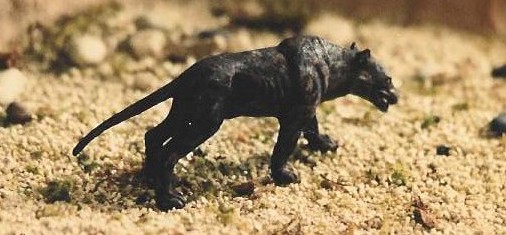From the Dinosaur Collector The Paleocene 65 million years ago the dinosaurs became extinct and the Mesozoic ended. The Cenozoic is divided into two parts the Tertiary and the Quaternary. The Tertiary lasted 63 million years and continued the flora which began developing at the end of the Cretaceous. Flowering plants continued to develop but grasses still had not evolved. The climate is warm even in the polar regions. Conifers remain wide spread but the number of species are not numerous. UPDATED 2/7/05
The Paleocene must have been seemed empty after the Cretaceous. Pantadonts were a diverse order of browsing animals that thrived in the Paleocene dying out in the Oligocene. They ranged from the size of rabbits to rhinos. Barylambda was one of the largest Paleocene mammals at around 650 kg. Its skeleton is of a cumbersome animal made for browsing by resting on its massive hind limbs and its heavy tail, which allowed to raise the front of the body and to brows the high branches. Their life style may have been like that of the extinct ground sloth.
The pantadont Barylamba from the Nabisco prehistoric mammal premium made by Lido. These figures are quite good for there time and it is still one of the the best toy figures of an early mammal. This figure is often misidentified as a sloth or dire wolf. It appears to be based on the Zallinger Age of mammals mural.
In the late Paleocene and middle Eocene the 9ft tall Diatryma dominated North America and perhaps Europe. They are alternately thought to have been the predators of the period or eaters of rushes and tussocks. They and a rare terrestrial alligator seem to the best candidates for top predator in the first Paleocene.
Diatryma from Bullyland. Diatryma was popularized by MPC series of the 60's.
The Eocene 54.8 to 33.7 mya. The name Eocene means the "dawn of recent life" Originally the Eocene was the first epoch of the Cenozoic, but then the Paleocene was erected as an earlier epoch. Life during the Eocene was pretty similar to that of the Paleocene, a warm tropic world, high sea-levels and island continents, invertebrates and plants similar to those today, while mammals continue to evolve and diversify along many lines
In the Late Paleocene and the Eocene there is Gastornis pariensis (Gaston's bird"). It is based on fragmentary early finds in Europe. A faulty reconstruction delayed recognition of the relationship to the North American Diatryma. They may be the same animal or at least very close relations. If so this would indicate continued contact between North America and Europe. Eohippus ( Dawn Horse) or Hyracotherium (mole beast) This primitive horse had 4 hoofed toes on the front feet and 3 hoofed toes on each hind foot. It had a long skull with 44 long-crowned teeth designed to browse on leaves and shoots.

Silver Dolphin Gastornis from their WWPB (Walking with Prehistoric Beasts) activity book. Eohippus from Starlux.
A Uintatherium surveys his surroundings before moving on toward the flood plain. It is a vegetarian and usually travels alone or in small groups.

Riff's Lost World JA RU Uintatherium. Custom diorama submitted by Riff Smith photo by Bob.
Uintatheres( DINOCERATA ) were ancient, distant cousin of horses, elephants and whales.. They first appeared near the end of the Paleocene and became extinct by the end of the Eocene. They left no decedents and their relationship to earlier forms are still debated. The may be related to Toxodonts and Liptoterns of South America. Uintatherium was 10 -15 feet long and lived in North America and Asia. It was the largest plant eater of its time.
Starlux Uintatherium, Starlux and Bullyland have produced the widest range of prehistoric mammals of all the figure companies. Most other mammal series have become extinct rather rapidly with not nearly the same diversity.
Moertherium the ancestor of the elephant family. The name refers to lake Moeris in Egypt where the fossils were found. This sheep sized animal is thought to have been semi aquatic like hippo of today. The were featured in the Eocene segment of the Walking with Prehistoric Beasts documentary.

Moertherium from Starlux.
Eobasileus cornuta (horned dawn king) had 6 bony knobs on its face. The rhino sized Eobasileus had saber canines and lived in the late Eocene. It was closely related to Uintatherium but a distinct animal.
PlayVision Eobasileus from the small mammal series and Diatryma by Mech.
Uintatheres like Eobasileus were small brained much like the dinosaurs that preceded them. These animals became larger and stranger looking over time until they died out. Despite the fang it is a plant eater.
Play Vision Eobasileus from the large mammal series labeled as a rhinoceros to which it is only distantly related. PlayVision based its figures on the The Simon and Schuster Encyclopedia of Dinosaurs and Prehistoric Creatures.
Paleotherium alternately Palaeotherium (old beast) an early off shoot of the line that lead to horses. It lived from Eocene to the Early Oligocene.

Starlux Paleotherium.
There were no mammalian carnivores for the first part of the Paleocene. The mesonychids were the first mammalian meat eaters and flourished until the Oligocene when creodonts and true carnivores replaced them. Most mesonychids were the size and shape of large wolves or bears, although some were as small as foxes. Members of this group had a heavy robust skull armed with sharp canine teeth and huge round-cusped molar teeth, suitable not only for eating meat but also for crushing bone. The body was also very wolf like, with a long tail and limbs. Like many modern carnivores, mesonychids walked on the tips of their long toes, rather than flat-footed. Despite all these carnivorous adaptations, however, mesonychids were derived from hoofed mammals. The proof is in their toes, which had hooves rather than claws. By the Middle Eocene (approximately 50 to 47 million years ago), the mesonychids had declined rapidly in North America and Eurasia, where once they had dominated. The reasons for this decline are unclear. This period was a time of major climatic change, with global cooling and drying that destroyed the dense forests where mesonychids once had ruled. With the coming of open habitats, prey species became faster and more agile. Large, clumsy predators like mesonychids might have had difficulty finding cover to ambush their prey. In addition, some paleontologists speculate that mesonychids were less efficient at eating meat than creodonts or carnivores, since the blunt, rounded cusps of mesonychid molars never developed the specialized, scissor like shearing edges found in more specialized carnivorous mammals. For whatever reasons, in the late Middle Eocene the mesonychids were very rare. They disappeared from North America at the end of the Middle Eocene (approximately 37 million years ago) and from Asia in the Late Eocene (about 34 million years ago).
The Mesonychid Andrewsarchus from the PlayVision small mammal series. A JA -RU Eobasileus from China.
One branch may have survived to this day in the oceans: the whales. Molecular biologists link them generally to the even-toed ungulates like Hippos, but many paleontologists favor a descent from the Mesonychia. The most primitive whales from early Eocene coastal deposits in Asia show some striking similarities to mesonychians. It seems likely that is is a case of convergent evolution.
Bullyland Andrewsarchus, from there mammal series. Bullyland has a large line of well done prehistoric mammals.
Andrewsarchus the last of the Asian mesonychids was a truly spectacular beast . Only one specimen of this animal is known, but it is a skull almost a meter long, more than twice the size of any bear that has ever lived. If the rest of the animal were also bear like, it would have been about four meters long, two meters high at the shoulder, and weighed almost four times as much as the largest known bear.
The striped Starlux and the Kaiydo Dino Tales Andrewsarchus. DinoTales has only done a few mammals but they are excellent figures.
The mesonychid carnivore Andrewsarchus seeks shelter in the woods. It is a fierce animal up to 13 feet long and it is primarily a scavenger but it will attack larger animals.

Riff's Lost World Starlux Andrewsarchus. Custom diorama submitted by Riff Smith photo by Bob.
Brontotherium was 8 ft high at the shoulder and lived in North America. Recently Brontotherium fossils have been redated from the Oligocene to the Late Eocene. Like many Eocene browsers they were not able to adapt fast enough the spread of the grasslands at the end of the Eocene.
Brontotherium from Ral Partha metal figure line and Nabisco premiums.
Return to Cenozoic Menu

 Click
on the Site A icon left for more diorama listed by location Click on the Site A
icon to the right for Dioramas organized by period or by manufacturer.
Click
on the Site A icon left for more diorama listed by location Click on the Site A
icon to the right for Dioramas organized by period or by manufacturer.
|
|